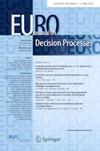Optimal supply chain design using machine learning, risk assessment and optimisation applied to coal distribution
IF 2.1
Q3 MANAGEMENT
引用次数: 0
Abstract
This paper presents a novel integration of machine learning and optimization techniques for robust supply chain network design under uncertainty, demonstrated through a regional coal distribution system (150 suppliers, 500 consumers, 7.5 million tonnes annually). Unlike traditional approaches that focus solely on cost minimization, our progressive methodology uniquely combines k-means clustering with mixed-integer programming to identify configurations that are both cost-effective and resilient to demand variability. Starting from a baseline single-warehouse configuration costing $404.6 million annually, our approach systematically evaluates multi-facility alternatives through Monte Carlo simulation (50,000 iterations), revealing remarkable system stability—only 0.96 % cost variation despite 25 % individual volume uncertainty. The k-means analysis identifies optimal clustering patterns, while subsequent mixed-integer programming confirms that a five-warehouse configuration reduces annual transportation costs by 45.8 % ($185.3 million savings) while maintaining 90–100 % capacity utilization. This configuration demonstrates a Net Present Value of $3.02 billion over 50 years, significantly outperforming traditional single-facility designs. Critically, correlation analysis reveals that shipment volumes (ρ=0.739) drive costs more than distances (ρ=0.556), challenging conventional distance-minimization paradigms. The integrated framework is computationally efficient (4.2 s to optimality), scalable to larger networks, and applicable to various bulk commodity distribution challenges, offering supply chain managers a robust tool for strategic network design under uncertainty.
将机器学习、风险评估和优化应用于煤炭配送的最优供应链设计
本文提出了一种新的机器学习和优化技术的集成,用于不确定性下的稳健供应链网络设计,并通过区域煤炭分配系统(150家供应商,500名消费者,每年750万吨)进行了演示。与只关注成本最小化的传统方法不同,我们的渐进式方法独特地将k均值聚类与混合整数规划相结合,以确定既具有成本效益又能适应需求变化的配置。从每年花费4.046亿美元的基线单仓库配置开始,我们的方法通过蒙特卡罗模拟(50,000次迭代)系统地评估了多设施替代方案,揭示了显着的系统稳定性-尽管25%的个体体积不确定性,但成本变化仅为0.96%。k-means分析确定了最佳聚类模式,而随后的混合整数规划证实,五仓库配置在保持90 - 100%的产能利用率的同时,每年可减少45.8%的运输成本(节省1.853亿美元)。这种配置在50年内的净现值为30.2亿美元,大大优于传统的单一设施设计。至关重要的是,相关分析表明,出货量(ρ=0.739)比距离(ρ=0.556)更能驱动成本,这挑战了传统的距离最小化范式。集成的框架具有计算效率(4.2 s达到最优),可扩展到更大的网络,并适用于各种大宗商品分销挑战,为供应链管理人员提供了不确定情况下战略网络设计的强大工具。
本文章由计算机程序翻译,如有差异,请以英文原文为准。
求助全文
约1分钟内获得全文
求助全文

 求助内容:
求助内容: 应助结果提醒方式:
应助结果提醒方式:


